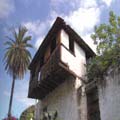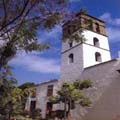History.
Before the conquest, the Daute district was peopled by the aborigine guanches, from the tribal group of the Ycodes. The Ycodes Canyon marks several places where the first settlers encountered a promising environment of water abundance and forest wealth.
At the end of the XV century, some Mallorcan monks establish themselves at the San Marcos Temple. The colonisers first establish it in a humble factory, where they worship the image of San Marcos, and later on in a temple of better construction.
The first settlers established themselves near the Ycod river, building houses, communication ways and preparing the lands for cultivation, planting vineyards, which gives the district its name. The fertile lands are also destined for the cultivation of sugar cane and cereals. The first industries are created: sugar mills, waterwheels and glass, among others.
The urban structure was definitely formed in the XVII century, obeying the dictates of the religious monastery principles that founded the convents, specially the Augustans and Franciscans.
Due to the agricultural and commercial prosperity and wealth, the population grew and it is named as the capital of Partido de Daute.
Places of Historical Interest
Álvarez House
 The Inquisition House (Casa de La Inquisición).
The Inquisition House (Casa de La Inquisición).
Moresque style, built at the end of the XVII century and at the beginning of the XVIII. It is believed that it housed the Court of the Holy Office.
Los Evora House.
Los Lorenzo Cáceres House
Los Pérez Domínguez House.
Second half of the XVIII century
Los Torres House
León Huerta House.
XVIII century
Padilla or Tabares House
XVII century
Fleytas House
San Antonio Drago
Temple of El Amparo
XVI Century
Las Angustias Temple
XVIII Century. It houses the Virgin of Las Angustias of Mexican baroque style and a painting of the Virgin of Candelaria from the XVIII century
San Antonio Temple
XVII Century
San Felipe Neri Temple
San Agustín Church
XVI century. Moresque roofing, San José rococo altarpiece from 1776. San Cayetano baroque altarpiece, 1687. Baroque chapel of Los Montiel.
Santa Lucía Marquee mansion
End of the XVIII century
Andrés de San Lorenzo Cáceres Plaza
XVI century and enlarged in the XVII and XVIII centuries
La Pila Plaza
With a fountain dating from the XVIII century
 San Marcos Parochial Church
San Marcos Parochial Church
Traditional architecture, with gothic elements, Moresque, baroque and neoclassical, built at the end of the XV century, although important reforms were carried out at the beginning of the XIX century. Part of the building is destined as a museum of sacro art. One of its works of higher artistic value is The Cross of Icod ( La Cruz de Icod) (Cuba 1663 – 1668) considered the largest cross of silver and filigree in the world; it measures 2,45 m and weighs 48,300 Kg
Historical Area
A great many of its streets are stoned.